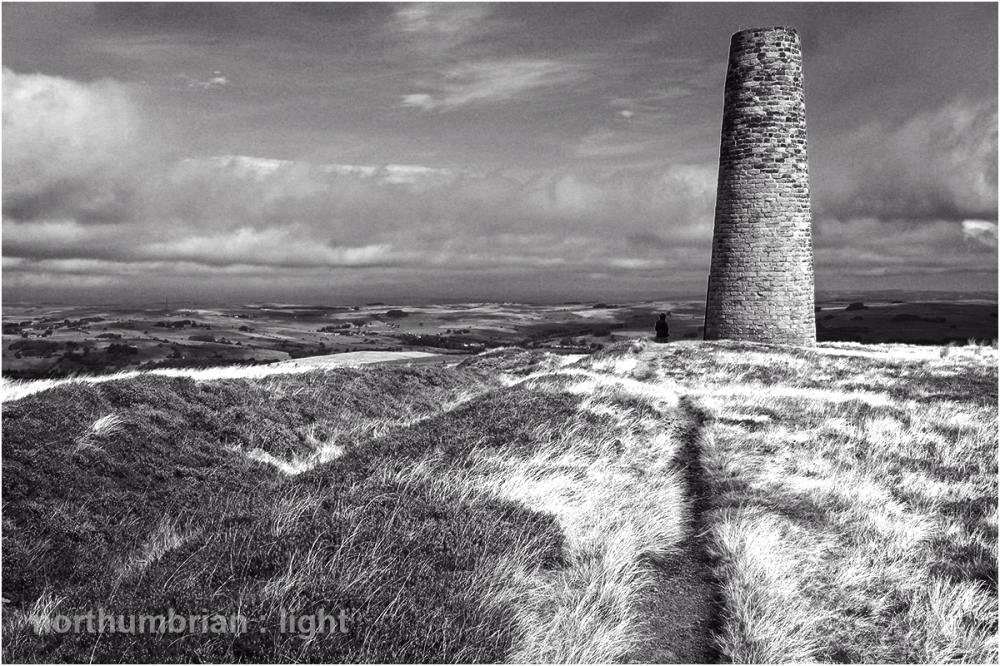A recent comment from one of my follower friends (Mark in Inverness) about his enthusiasm for chimneys got me thinking that I probably share his passion – there are quite a few chimneys in my archive, many from the English canals. Indeed, chimneys even get mentioned in Golf in the Wild. This is the description of Allendale’s glorious third which provides the opportunity for another pop at the banking fraternity (see previous post):
Everything about this hole is on the vertical plane, a portrait rather than landscape view. The approach to the green is framed by trees right and left and the eye is drawn upwards to Flow Moss and the Allen Mill chimney, after which the hole is named; the top of another chimney, set further back, is also visible on clear days. The chimneys and their flues were built in 1808 to vent sulphur and arsenic, a by-product of the Allen Mill lead ore smelting process which first started operating in 1692. The Allen Valley was once the richest source of lead in Britain. The smelt mill down near the railway station has largely gone but there are some significant remnants including stone storage bunkers, a condensing chamber, silver smelter and a flue opening. The flue system runs from Allen Mill to the chimneys with some impressive statistics; at their widest and highest they are over 6 feet and 24 feet respectively and run for over 2 miles. While some stretches have collapsed much remains and a walk to the chimneys allows a closer inspection of one of the best preserved flue systems in England, now a Scheduled Monument.
Lead ore can contain significant concentrations of silver and this was recognised in the construction of the flues; doors gave access to enable the silver to be scraped or brushed from the lining; is this where the phrase ‘daft as a brush’ derives from, the sulphur and arsenic having the same effect as mercury on a mad hatter. The lead brought the railways, the railways brought the people and the people played golf.
From the third tee keep the idea of chimneys in your mind and try floating a ball down the stack and onto the green; you can come up short on the bank but, in the summer, the ball may bounce off the slope and over the back of the green, requiring the use of crampons to retrieve it. In the winter the ball will simply stop dead. The approach to the same green from the twelfth tee on the back nine is wholly different and characterises how the local course designers cleverly extracted the best from the land available. Offset to the right and further down the hill, Crow’s Nest invites an ace. It is known as the Northern Rock shot; pitch the ball to the left and use the run on the bank to gather the ball to the hole. I offer no apologies to Adam Applegarth; I am still waiting for his.
This is my youngest son’s interpretation of the iconic chimneys and Allendale Golf Club:
Golf in the Wild – now available worldwide on Amazon.


magnificant
Many thanks – Northumberland at is its very best.
Beautiful image, pretty well composed 🙂
But, as I scrolled down, I am confused, which one is better? The painting or the photograph 🙂
Many thanks – we had better say that junior’s painting is the better of the two 🙂
This is a great shot!
Many thanks Hanne
Ah, chimneys of past industry…..I have quite a few in my archives! 😀
I think we should lobby for a chimney themed photo challenge 🙂
You can set one up!!
Too busy/lazy/confused – delete as appropriate 😉
Hopefully !!!! and please send it to me, so that I can make a post on my blog about industrial chimneys of brickmasonry.
bloggracia.wordpress.com
The chimney is a lonely figure on that landscape. I can imagine that the people who worked in those mills didn’t live long.
It is, quite bleak up on Flow Moss. I can’t find any mortality figures but I am sure you are right it would have been a grim business. Some of the mines are accessible and there are people who like to venture down them – not me! The miners did have one compensation though – they could collect Bonnie Bits – http://www.ukminingventures.com/MinesIntro.htm
Excellent. Beautiful pictures and a fascinating history, I never knew about ‘daft as a brush’.
Next week, aqueducts? Much appreciated
Thanks Mark. Daft as a brush may be Mancunian. Being a canal enthusiast, I can do aqueducts too 🙂
This is what happens when you don’t pay close attention! There I was looking for a Lutyens style chimney, and you’d already given me a clue. Now I see the error of my ways. But very beautiful 🙂
Aha – Lutyens – the master chimney designer. This one is more functional but just perfect for the bleak landscape that is Flow Moss. A great walk if you are ever up that way – just follow the flues 🙂
Reblogged this on Chimeneas Industriales de ladrillo and commented:
Algunos otros también se interesan por las chimeneas y quedan atraídos por ellas
Many thanks for the reblog and all the best for 2015
Thanks to you. My best wishes also for you.